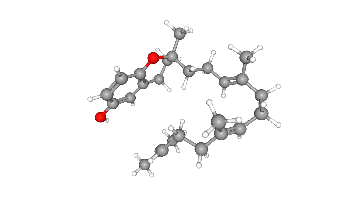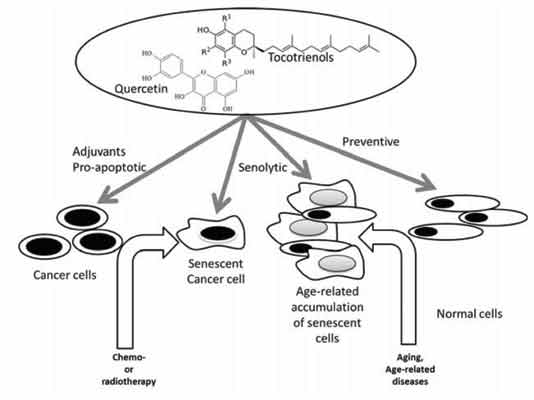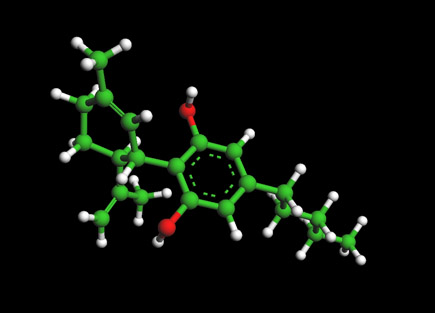Tocotrienols-Anti-Aging and Senolytic Properties

Ball and Stick Model for delta- Tocotrienol Molecule
DelTocotrienol Conformer Molecule (above) Ball-and-stick. For 3D Jsmol File
Chemical formula--C27H38O2
Molar Mass --- 396.6 g/mol
What is the difference between tocotrienols and tocopherols?
The vitamin E family comprise four tocotrienols (alpha, beta, gamma, delta) and four tocopherols (alpha, beta, gamma, delta). The critical chemical structural difference between tocotrienols and tocopherols is that tocotrienols have unsaturated isoprenoid side chains with three carbon-carbon double bonds versus saturated side chains for tocopherols.
Tocotrienols are compounds naturally occurring at higher levels in some vegetable oils, including palm oil, rice bran oil, wheat germ, barley, saw palmetto, annatto, and certain other types of seeds, nuts and grains, and the oils derived from them.
Tocotrienols Molecular Structure

Bioavailability of Tocotrienols
13 January 2014 Bioavailability of tocotrienols: evidence in human studies
As a minor component of vitamin E, tocotrienols were evident in exhibiting biological activities such as neuroprotection, radio-protection, anti-cancer, anti-inflammatory and lipid lowering properties which are not shared by tocopherols. However, available data on the therapeutic window of tocotrienols remains controversial. It is important to understand the absorption and bioavailability mechanisms before conducting in-depth investigations into the therapeutic efficacy of tocotrienols in humans. In this review, we updated current evidence on the bioavailability of tocotrienols from human studies. Available data from five studies suggested that tocotrienols may reach its target destination through an alternative pathway despite its low affinity for α-tocopherol transfer protein. This was evident when studies reported considerable amount of tocotrienols detected in HDL particles and adipose tissues after oral consumption. Besides, plasma concentrations of tocotrienols were shown to be higher when administered with food while self-emulsifying preparation of tocotrienols was shown to enhance the absorption of tocotrienols. Nevertheless, mixed results were observed based on the outcome from 24 clinical studies, focusing on the dosages, study populations and formulations used. This may be due to the variation of compositions and dosages of tocotrienols used, suggesting a need to understand the formulation of tocotrienols in the study design. Essentially, implementation of a control diet such as AHA Step 1 diet may influence the study outcomes, especially in hypercholesterolemic subjects when lipid profile might be modified due to synergistic interaction between tocotrienols and control diet. We also found that the bioavailability of tocotrienols were inconsistent in different target populations, from healthy subjects to smokers and diseased patients. In this review, the effect of dosage, composition and formulation of tocotrienols as well as study populations on the bioavailability of tocotrienols will be discussed. ..see full publication
20 November 2018 Anti-inflammatory Activity of Tocotrienols in Age-related Pathologies: A SASPected Involvement of Cellular Senescence
Tocotrienols (T3) have been shown to represent a very important part of the vitamin E family since they have opened new opportunities to prevent or treat a multitude of age-related chronic diseases. The beneficial effects of T3 include the amelioration of lipid profile, the promotion of Nrf2 mediated cytoprotective activity and the suppression of inflammation. All these effects may be the consequence of the ability of T3 to target multiple pathways. We here propose that these effects may be the result of a single target of T3, namely senescent cells. Indeed, T3 may act by a direct suppression of the senescence-associated secretory phenotype (SASP) produced by senescent cells, mediated by inhibition of NF-kB and mTOR, or may potentially remove the origin of the SASP trough senolysis (selective death of senescent cells). Further studies addressed to investigate the impact of T3 on cellular senescence "in vitro" as well as in experimental models of age-related diseases "in vivo" are clearly encouraged. see full publicatjon
7 August 2010--Tocotrienols, the Vitamin E of the 21st Century: It's Potential Against Cancer and Other Chronic Diseases
Initially discovered in 1938 as a "fertility factor," vitamin E now refers to eight different isoforms that belong to two categories, four saturated analogues (α, β, γ, and δ) called tocopherols and four unsaturated analogues referred to as tocotrienols. While the tocopherols have been investigated extensively, little is known about the tocotrienols. Very limited studies suggest that both the molecular and therapeutic targets of the tocotrienols are distinct from those of the tocopherols. For instance, suppression of inflammatory transcription factor NF-κB, which is closely linked to tumorigenesis and inhibition of HMG-CoA reductase, mammalian DNA polymerases and certain protein tyrosine kinases, is unique to the tocotrienols. This review examines in detail the molecular targets of the tocotrienols and their roles in cancer, bone resorption, diabetes, and cardiovascular and neurological diseases at both preclinical and clinical levels. As disappointment with the therapeutic value of the tocopherols grows, the potential of these novel vitamin E analogues awaits further investigation. see full publication
2016 --Pleiotropic Effects of Tocotrienols and Quercetin on Cellular Senescence: Introducing the Perspective of Senolytic Effects of Phytochemicals.
The possibility to target cellular senescence with natural bioactive substances open interesting therapeutic perspective in cancer and aging. Engaging senescence response is suggested as a key component for therapeutic intervention in the eradication of cancer. At the same time, delaying senescence or even promote death of accumulating apoptosis-resistant senescent cells is proposed as a strategy to prevent age related diseases. Although these two desired outcome present an intrinsic dichotomy, there are examples of promising natural compounds that appear to satisfy all the requirements to develop senescence- targeted health promoting nutraceuticals. Tocotrienols (T3s) and quercetin (QUE), albeit belonging to different phytochemical classes, display similar and promising effects "in vitro" when tested in normal and cancer cells. Both compounds have been shown to induce senescence and promote apoptosis in a multitude of cancer lines. 
Above: Iage showing Pleiotropic Effects of Tocotrienols and Quercetin
Conversely, they display senescence delaying activity in primary cells and rejuvenating effects in senescent cells. More recently, QUE has been shown to display senolytic effects in some primary senescent cells, likely as a consequence of its inhibitory effects on specific anti-apoptotic genes (i.e. PI3K and other kinases). Senolytic activity has not been tested for T3s but part of metabolic and apoptotic pathways affected by these compounds in cancer cells overlap with those of QUE. This suggests that the rejuvenating effects of T3s and QUE on pre-senescent and senescent primary cells might be the net results of a senolytic activity on senescent cells and a selective survival of a sub-population of non-senescent cells in the culture. The meaning of this hypothesis in the context of adjuvant therapy of cancer and preventive anti-aging strategies with QUE or T3s is discussed.---source
17 February 2016 The Tocotrienol-Rich Fraction Is Superior to Tocopherol in Promoting Myogenic Differentiation in the Prevention of Replicative Senescence of Myoblasts
Aging results in a loss of muscle mass and strength. Myoblasts play an important role in maintaining muscle mass through regenerative processes, which are impaired during aging. Vitamin E potentially ameliorates age-related phenotypes. Hence, this study aimed to determine the effects of the tocotrienol-rich fraction (TRF) and α-tocopherol (ATF) in protecting myoblasts from replicative senescence and promoting myogenic differentiation. Primary human myoblasts were cultured into young and senescent stages and were then treated with TRF or ATF for 24 h, followed by an analysis of cell proliferation, senescence biomarkers, cellular morphology and differentiation. Our data showed that replicative senescence impaired the normal regenerative processes of myoblasts, resulting in changes in cellular morphology, cell proliferation, senescence-associated β-galactosidase (SA-β-gal) expression, myogenic differentiation and myogenic regulatory factors (MRFs) expression. Treatment with both TRF and ATF was beneficial to senescent myoblasts in reclaiming the morphology of young cells, improved cell viability and decreased SA-β-gal expression. However, only TRF treatment increased BrdU incorporation in senescent myoblasts, as well as promoted myogenic differentiation through the modulation of MRFs at the mRNA and protein levels. MYOD1 and MYOG gene expression and myogenin protein expression were modulated in the early phases of myogenic differentiation. In conclusion, the tocotrienol-rich fraction is superior to α-tocopherol in ameliorating replicative senescence-related aberration and promoting differentiation via modulation of MRFs expression, indicating vitamin E potential in modulating replicative senescence of myoblasts. source
February 2019 Anticancer properties of tocotrienols: A review of cellular mechanisms and molecular targets.
Vitamin E is composed of two groups of compounds: α-, β-, γ-, and δ-tocopherols (TPs), and the corresponding unsaturated tocotrienols (TTs). TTs are found in natural sources such as red palm oil, annatto seeds, and rice bran. In the last decades, TTs (specifically, γ-TT and δ-TT) have gained interest due to their health benefits in chronic diseases, based on their antioxidant, neuroprotective, cholesterol-lowering, anti-inflammatory activities. Several in vitro and in vivo studies pointed out that TTs also exert a significant antitumor activity in a wide range of cancer cells. Specifically, TTs were shown to exert antiproliferative/proapoptotic effects and to reduce the metastatic or angiogenic properties of different cancer cells; moreover, these compounds were reported to specifically target the subpopulation of cancer stem cells, known to be deeply involved in the development of resistance to standard therapies. Interestingly, recent studies pointed out that TTs exert a synergistic antitumor effect on cancer cells when given in combination with either standard antitumor agents (i.e., chemotherapeutics, statins, "targeted" therapies) or natural compounds with anticancer activity (i.e., sesamin, epigallocatechin gallate (EGCG), resveratrol, ferulic acid). Based on these observations, different TT synthetic derivatives and formulations were recently developed and demonstrated to improve TT water solubility and to reduce TT metabolism in cancer cells, thus increasing their biological activity. These promising results, together with the safety of TT administration in healthy subjects, suggest that these compounds might represent a new chemopreventive or anticancer treatment (i.e., in combination with standard therapies) strategy. Clinical trials aimed at confirming this antitumor activity of TTs are needed. see source
Anti-Aging and Senolytics Home Page
- What is Anti-Aging Medicine
- What is Senescence?
- What are Senolytics?
- About Caloric Restriction
- Mtor and Rapamycin
- The IKK/NF-κB signaling pathway in aging
- Exercise and Anti-Aging
- Meditation and Anti-Aging
SENOLYTIC AND ANTI-AGING MOLECULES
RAPAMYCIN ---The mechanistic target of rapamycin (mTOR) pathway has a central role in cell activation...
METFORMIN -- The diabetes drug metformin used by some for anti-aging may diminish benefits of aerobic exercise...
QUERCETIN-- AND WITH DASATINIB--The senolytic cocktail, dasatinib plus quercetin, which causes selective elimination of senescent cells...
FISETIN--Of the 10 flavonoids tested, fisetin was the most potent senolytic...
EGCG- The most active component of green tea....
NAD BOOSTERS --'...The cells of the old mice were indistinguishable from the young mice, after just one week of treatment...
SULFORAPHANE-- An isothiocyanate present in cruciferous vegetables activates antioxidant and anti-inflammatory responses by ...
UROLITHIN --Metabolite of Pomegranate compound with anti-aging effects passes human trial...
MITO-Q -- A water soluble fomr of CoQ10 that has excellent absorption and high bioavailability...
HONOKIOL - A bioactive natural product derived from Magnolia Bark have demonstrated ...
CURCUMIN AND ANALOGS -Recent research is focused on the design and synthesis of curcumin analogs as antiproliferative and anti-inflammatory agents...
BERBERINE --berberine has recently been reported to expand life span in Drosophila melanogaster, and attenuate premature cellular senescence
N-ACETYL-CYSTINE (NAC)--"...pretreatment with NAC increased glutathione levels in the older cells and largely helped offset that level of cell death..."
PIPERLONGUMINE - A natural product from the Long pepper with high bioavailability...
RESVERATROL AND PTEROTSILBINE -- Pterostilben chemically similar to resveratrol bute differs from resveratrol by exhibiting increased bioavailability (80% compared to 20% in resveratrol)
SPERMIDINE--Spermidine delays aging in humans ...
ALLICIN -- Allicin is a compound produced when garlic is crushed or chopped. ...
VITAMIN D3 -- Production of the active forms of Vitamin D are reduced by 50% as a result of an age-related decline
VITAMIN K-- evidence suggests vitamin K has an anti-inflammatory action
TOCOTRIENOL(AND WITH QUERCETIN) --Tocotrieniols have been found to exert a synergistic antitumor effect on cancer cells when given in combination....
HSP-90 INHIBITORS --As a novel class of senolytics
The Cannabidiol Molecule
Cannabidiol (CBD is the major non-psychoactive component of Cannabis and is being looked at by major drug and consumer companies for various medical and social uses.